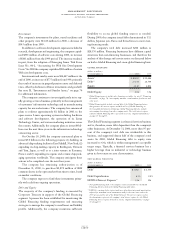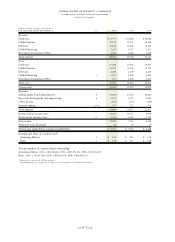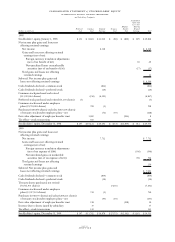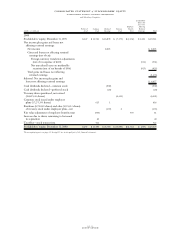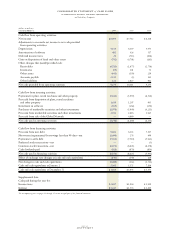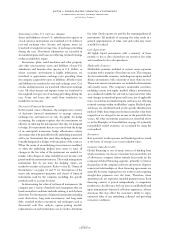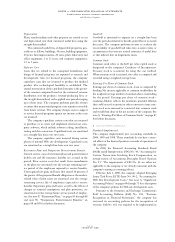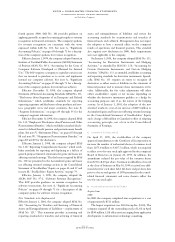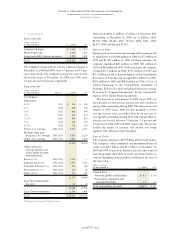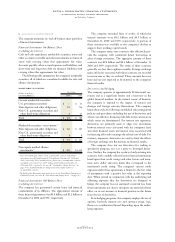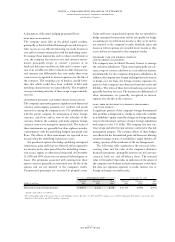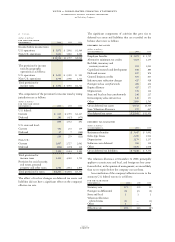IBM 2000 Annual Report Download - page 72
Download and view the complete annual report
Please find page 72 of the 2000 IBM annual report below. You can navigate through the pages in the report by either clicking on the pages listed below, or by using the keyword search tool below to find specific information within the annual report.
Translation of Non-U.S. Currency Amounts
Assets and liabilities of non-U.S. subsidiaries that operate in
a local currency environment are translated to U.S. dollars at
year-end exchange rates. Income and expense items are
translated at weighted-average rates of exchange prevailing
during the year. Translation adjustments are recorded in
Accumulated gains and losses not affecting retained earnings
within stockholders’ equity.
Inventories, plant, rental machines and other property,
and other non-monetary assets and liabilities of non-U.S.
subsidiaries and branches that operate in U.S. dollars, or
whose economic environment is highly inflationary, are
translated at approximate exchange rates prevailing when
the company acquired the assets or liabilities. All other assets
and liabilities are translated at year-end exchange rates. Cost
of sales and depreciation are translated at historical exchange
rates. All other income and expense items are translated at
the weighted-average rates of exchange prevailing during the
year. Gains and losses that result from translation are
included in net income.
Derivative/Financial Instruments
In the normal course of business, the company uses a variety
of derivative financial instruments to manage currency
exchange rate and interest rate risk. To qualify for hedge
accounting, the company requires that the instruments are
effective in reducing the risk exposure that they are designed
to hedge. For instruments that are associated with the hedge
of an anticipated transaction, hedge effectiveness criteria
also require that it be probable that the underlying transaction
will occur. Instruments that meet these hedging criteria are
formally designated as hedges at the inception of the contract.
When the terms of an underlying transaction are modified,
or when the underlying hedged item ceases to exist, all
changes in the fair value of the instrument are marked-to-
market with changes in value included in net income each
period until the instrument matures. Those risk management
instruments that do not meet the hedging criteria are
marked-to-market each period. Refer to note K, “Financial
Instruments,” on pages 76 and 77 for descriptions of the
major risk management programs and classes of financial
instruments used by the company, including the specific
methods used to account for them.
In determining fair value of its financial instruments, the
company uses a variety of methods and assumptions that are
based on market conditions and risks existing at each balance
sheet date. For the majority of financial instruments including
most derivatives, long-term investments and long-term
debt, standard market conventions and techniques such as
discounted cash flow analysis, option pricing models,
replacement cost and termination cost are used to determine
fair value. Dealer quotes are used for the remaining financial
instruments. All methods of assessing fair value result in a
general approximation of value, and such value may never
actually be realized.
Cash Equivalents
All highly liquid investments with a maturity of three
months or less at date of purchase are carried at fair value
and considered to be cash equivalents.
Marketable Securities
Marketable securities included in current assets represent
securities with a maturity of less than one year. The company
also has marketable securities, including non-equity method
alliance investments, with a maturity of more than one year.
These non-current investments are included in Investments
and sundry assets. The company’s marketable securities,
including certain non-equity method alliance investments,
are considered available for sale and are reported at fair value
with changes in unrealized gains and losses, net of applicable
taxes, recorded in Accumulated gains and losses not affecting
retained earnings within stockholders’ equity. Realized gains
and losses are calculated based on the specific identification
method. Other than temporary declines in market value from
original cost are charged to net income in the period the loss
occurs. All other investment securities not described above
or in the Principles of Consolidation on page 69, primarily
non-publicly traded securities, are accounted for using the
cost method.
Inventories
Raw materials, work in process and finished goods are stated
at the lower of average cost or net realizable value.
Customer Loan Receivables
Global Financing is one of many sources of funding from
which customers can choose. Customer loan receivables, net
of allowances, comprise almost entirely loans made by the
company’s Global Financing segment, primarily to finance
the purchase of the company’s software and services. Separate
contractual relationships on these financing agreements are
generally for terms ranging from one to three years requiring
straight-line payments over the term. Therefore, these
agreements do not represent extended payment terms. Each
financing contract is priced independently at competitive
market rates. An allowance for loan losses is established based
upon management’s historical collection experience, adverse
situations that may affect the customer’s ability to repay,
estimated value of any underlying collateral and prevailing
economic conditions.
notes to consolidated financial statements
international business machines corporation
and Subsidiary Companies
page no.
seventy


